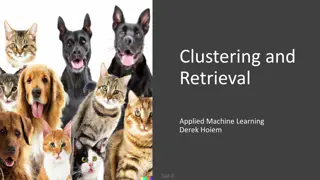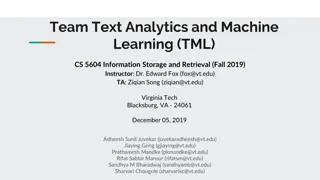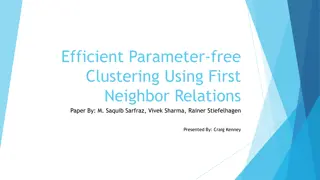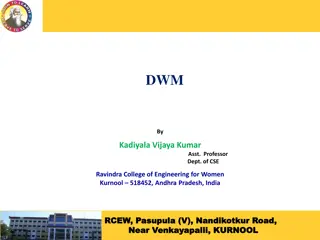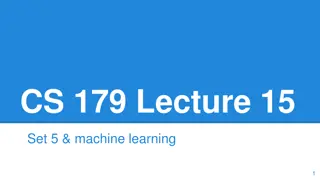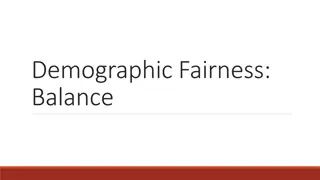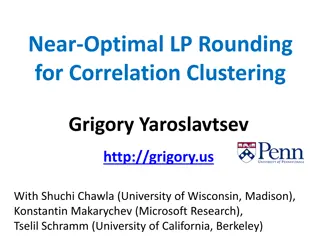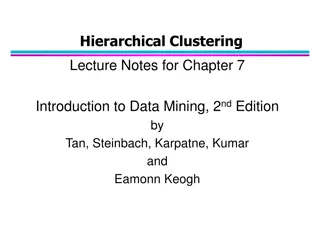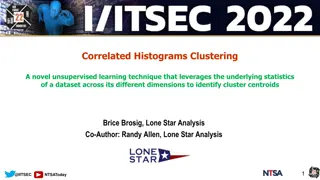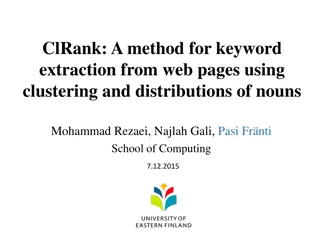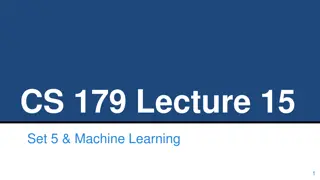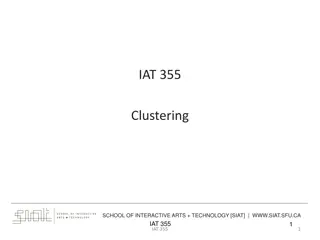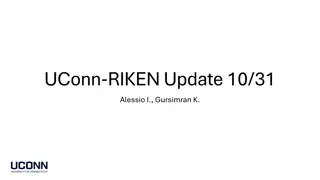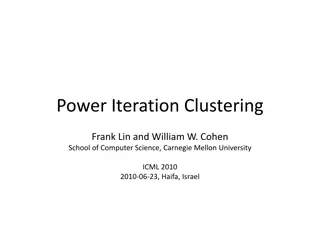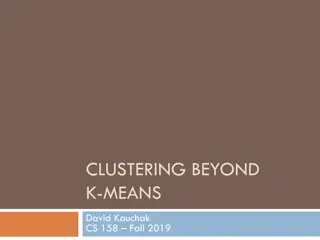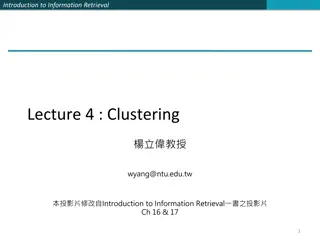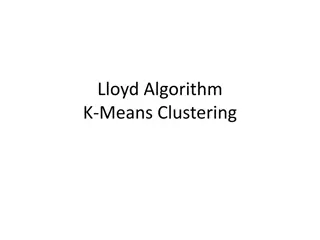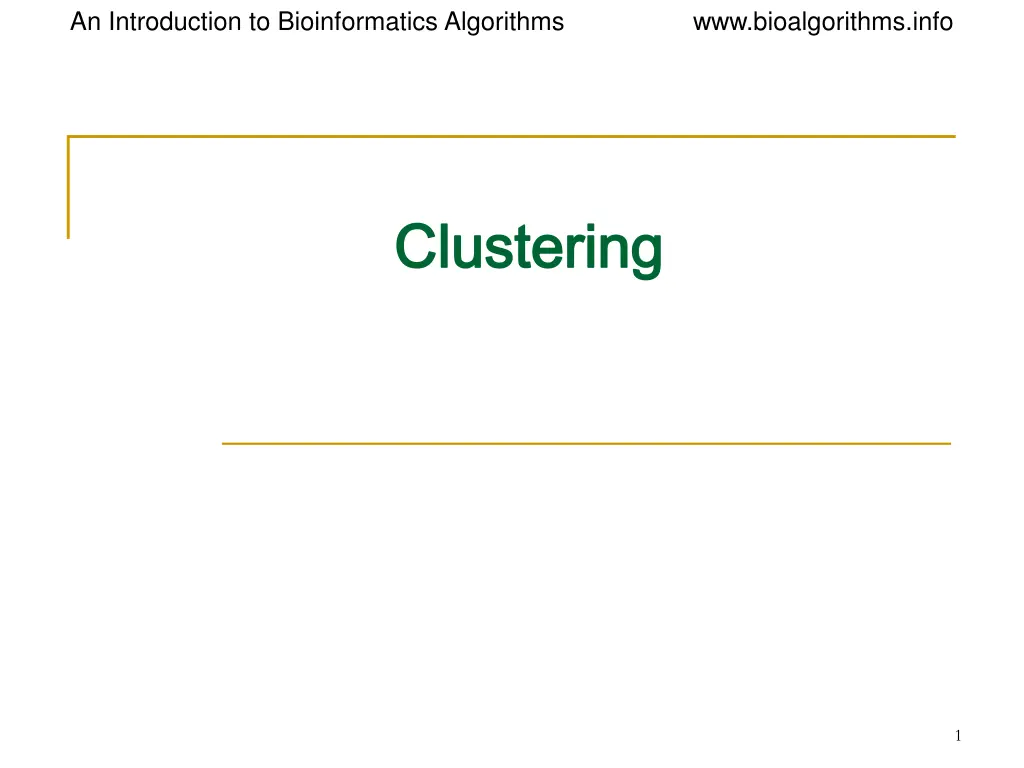
Bioinformatics Algorithms Overview
Explore the world of bioinformatics algorithms, including clustering, inferring gene functionality, microarrays, and expression analysis. Learn how bioinformatics is used to analyze biological data and infer gene functions from DNA sequences. Discover the applications of clustering in organizing vast amounts of biological data into clusters of similar data points.
Uploaded on | 1 Views
Download Presentation

Please find below an Image/Link to download the presentation.
The content on the website is provided AS IS for your information and personal use only. It may not be sold, licensed, or shared on other websites without obtaining consent from the author. If you encounter any issues during the download, it is possible that the publisher has removed the file from their server.
You are allowed to download the files provided on this website for personal or commercial use, subject to the condition that they are used lawfully. All files are the property of their respective owners.
The content on the website is provided AS IS for your information and personal use only. It may not be sold, licensed, or shared on other websites without obtaining consent from the author.
E N D
Presentation Transcript
An Introduction to Bioinformatics Algorithms www.bioalgorithms.info Clustering Clustering 1
An Introduction to Bioinformatics Algorithms Outline www.bioalgorithms.info Microarrays Hierarchical Clustering K-Means Clustering Corrupted Cliques Problem CAST Clustering Algorithm 3
An Introduction to Bioinformatics Algorithms Applications of Clustering www.bioalgorithms.info Viewing and analyzing vast amounts of biological data as a whole set can be perplexing It is easier to interpret the data if they are partitioned into clusters combining similar data points. 4
An Introduction to Bioinformatics Algorithms Inferring Gene Functionality www.bioalgorithms.info Researchers want to know the functions of newly sequenced genes Simply comparing the new gene sequences to known DNA sequences often does not give away the function of gene For 40% of sequenced genes, functionality cannot be ascertained by only comparing to sequences of other known genes Microarrays allow biologists to infer gene function even when sequence similarity alone is insufficient to infer function. 5
An Introduction to Bioinformatics Algorithms Microarrays and Expression Analysis www.bioalgorithms.info Microarrays measure the activity (expression level) of the genes under varying conditions/time points Expression level is estimated by measuring the amount of mRNA for that particular gene A gene is active if it is being transcribed More mRNA usually indicates more gene activity 6
An Introduction to Bioinformatics Algorithms Microarray Experiments www.bioalgorithms.info Produce cDNA from mRNA (DNA is more stable) Attach phosphor to cDNA to see when a particular gene is expressed Different color phosphors are available to compare many samples at once Hybridize cDNA over the micro array Scan the microarray with a phosphor-illuminating laser Illumination reveals transcribed genes Scan microarray multiple times for the different color phosphor s 7
An Introduction to Bioinformatics Algorithms Microarray Experiments (con t) www.bioalgorithms.info Phosphors can be added here instead Then instead of staining, laser illumination can be used www.affymetrix.com 8
An Introduction to Bioinformatics Algorithms Using Microarrays www.bioalgorithms.info Green: expressed only from control Red: expressed only from experimental cell Yellow: equally expressed in both samples Black: NOT expressed in either control or experimental cells 9
An Introduction to Bioinformatics Algorithms Clustering of Microarray Data Plot each datum as a point in N-dimensional space Make a distance matrix for the distance between every two gene points in the N- dimensional space Genes with a small distance share the same expression characteristics and might be functionally related or similar. Clustering reveal groups of functionally related genes www.bioalgorithms.info 11
An Introduction to Bioinformatics Algorithms www.bioalgorithms.info Clustering of Microarray Data (cont d) Clusters 12
An Introduction to Bioinformatics Algorithms www.bioalgorithms.info Homogeneity and Separation Principles Homogeneity: Elements within a cluster are close to each other Separation: Elements in different clusters are further apart from each other Given these points a clustering algorithm might make two distinct clusters as follows 13
An Introduction to Bioinformatics Algorithms Bad Clustering www.bioalgorithms.info This clustering violates both Homogeneity and Separation principles Close distances from points in separate clusters Far distances from points in the same cluster 14
An Introduction to Bioinformatics Algorithms Good Clustering www.bioalgorithms.info This clustering satisfies both Homogeneity and Separation principles 15
An Introduction to Bioinformatics Algorithms Clustering Techniques www.bioalgorithms.info Agglomerative: Start with every element in its own cluster, and iteratively join clusters together Divisive: Start with one cluster and iteratively divide it into smaller clusters Hierarchical: Organize elements into a tree, leaves represent genes and the length of the pathes between leaves represents the distances between genes. Similar genes lie within the same subtrees 16
An Introduction to Bioinformatics Algorithms Hierarchical Clustering www.bioalgorithms.info 17
An Introduction to Bioinformatics Algorithms Hierarchical Clustering Algorithm www.bioalgorithms.info 1. 2. 3. 4. 5. 6. 7. 8. 9. 10. 11. Hierarchical Clustering (d d , n) Form n clusters each with one element Construct a graph T T by assigning one vertex to each cluster Find the two closest clusters C1 and C2 Merge C1 and C2 into new cluster C with |C1| +|C2| elements Add a new vertex C C to T T and connect to vertices C1 and C2 Remove rows and columns of d d corresponding to C1 and C2 Add a row and column to d d corrsponding to the new cluster C C 4. while while there is more than one cluster 7. Compute distance from Compute distance from C C to all other clusters to all other clusters 11. return T T The algorithm takes a nxn distance matrix d of pairwise distances between points as an input. 18
An Introduction to Bioinformatics Algorithms Hierarchical Clustering Algorithm www.bioalgorithms.info 1. 2. 3. 4. 5. 6. 7. 8. 9. 10. 11. Hierarchical Clustering (d d , n) Form n n clusters each with one element Construct a graph T T by assigning one vertex to each cluster Find the two closest clusters C1 and C2 Merge C1 and C2 into new cluster C with |C1| +|C2| elements Add a new vertex C C to T T and connect to vertices C1 and C2 Remove rows and columns of d d corresponding to C1 and C2 Add a row and column to d d corrsponding to the new cluster C C 4. while while there is more than one cluster 7. Compute distance from Compute distance from C C to all other clusters to all other clusters 11. return T T Different ways to define distances between clusters may lead to different clusterings 19
An Introduction to Bioinformatics Algorithms www.bioalgorithms.info Hierarchical Clustering: Recomputing Distances dmin(C, C*) = min d(x,y) for all elements x in C and y in C* Distance between two clusters is the smallest distance between any pair of their elements davg(C, C*) = (1 / |C*||C|) d(x,y) for all elements x in C and y in C* Distance between two clusters is the average distance between all pairs of their elements 20
An Introduction to Bioinformatics Algorithms Squared Error Distortion www.bioalgorithms.info Given a data pointv and a set of points X, define the distance from v to X d(v, X) as the (Eucledian) distance from v to the closest point from X. Given a set of n data pointsV={v1 vn} and a set of k points X, define the Squared Error Distortion d(V,X) = d(vi, X)2 / n 1 < i < n 21
An Introduction to Bioinformatics Algorithms www.bioalgorithms.info K-Means Clustering Problem: Formulation Input: A set, V, consisting of n points and a parameter k Output: A set X consisting of k points (cluster centers) that minimizes the squared error distortion d(V,X) over all possible choices of X 22
An Introduction to Bioinformatics Algorithms www.bioalgorithms.info 1-Means Clustering Problem: an Easy Case Input: A set, V, consisting of n points Output: A single points x (cluster center) that minimizes the squared error distortion d(V,x) over all possible choices of x 23
An Introduction to Bioinformatics Algorithms www.bioalgorithms.info 1-Means Clustering Problem: an Easy Case Input: A set, V, consisting of n points Output: A single points x (cluster center) that minimizes the squared error distortion d(V,x) over all possible choices of x 1-Means Clustering problem is easy. However, it becomes very difficult (NP-complete) for more than one center. An efficient heuristic method for K-Means clustering is the Lloyd algorithm 24
An Introduction to Bioinformatics Algorithms K-Means Clustering: Lloyd Algorithm 1. Lloyd Algorithm 2. Arbitrarily assign the k cluster centers 3. 4. Assign each data point to the cluster Ci cluster k) 5. After the assignment of all data points, v \ |C| for all v in C for every cluster C *This may lead to merely a locally optimal clustering. www.bioalgorithms.info 3. while while the cluster centers keep changing corresponding to the closest representative (center) (1 i compute new cluster representatives according to the center of gravity of each cluster, that is, the new cluster representative is 25
An Introduction to Bioinformatics Algorithms www.bioalgorithms.info 5 expression in condition 2 4 x1 3 x2 2 1 x3 0 0 1 expression in condition 1 2 3 4 5 26
An Introduction to Bioinformatics Algorithms www.bioalgorithms.info 5 expression in condition 2 4 x1 3 x2 2 1 x3 0 0 1 expression in condition 1 2 3 4 5 27
An Introduction to Bioinformatics Algorithms www.bioalgorithms.info 5 expression in condition 2 4 x1 3 2 x3 x2 1 0 0 1 expression in condition 1 2 3 4 5 28
An Introduction to Bioinformatics Algorithms www.bioalgorithms.info 5 expression in condition 2 4 x1 3 2 x2 x3 1 0 0 1 expression in condition 1 2 3 4 5 29
An Introduction to Bioinformatics Algorithms Conservative K-Means Algorithm www.bioalgorithms.info Lloyd algorithm is fast but in each iteration it moves many data points, not necessarily causing better convergence. A more conservative method would be to move one point at a time only if it improves the overall clustering cost (Squared Error Distortion is one particular choice of cost) The smaller the clustering cost of a partition of data points is the better that clustering is Different methods (e.g., the squared error distortion) can be used to measure this clustering cost 30
An Introduction to Bioinformatics Algorithms K-Means Greedy Algorithm www.bioalgorithms.info 1. 2. 3. 4. 5. 6. 7. 8. 9. 10. i* I 11. C* C 12. 13. Change partition P by moving i* to C* 14. else 15. ProgressiveGreedyK-Means(k) Select an arbitrary partition P into k clusters while bestChange 0 if if (cost(P) cost(Pi C) > bestChange bestChange cost(P) cost(Pi C) 3. while forever 5. 6. 7. for for if if moving i to cluster C reduces its clustering cost for every cluster C for every element i not in C 12. if if bestChange > 0 else return 15. return P 31
An Introduction to Bioinformatics Algorithms Clique Graphs www.bioalgorithms.info A clique is a graph with every vertex connected to every other vertex A clique graph is a graph where each connected component is a clique 32
An Introduction to Bioinformatics Algorithms Transforming an Arbitrary Graph into a Clique Graphs A graph can be transformed into a clique graph by adding or removing edges www.bioalgorithms.info 33
An Introduction to Bioinformatics Algorithms Corrupted Cliques Problem www.bioalgorithms.info Input: A graph G Output: The smallest number of additions and removals of edges that will transform G into a clique graph 35
An Introduction to Bioinformatics Algorithms Distance Graphs www.bioalgorithms.info Turn the distance matrix into a distance graph Genes are represented as vertices in the graph Choose a distance threshold If the distance between two vertices is below , draw an edge between them The resulting graph may contain cliques These cliques represent clusters of closely located data points! 36
An Introduction to Bioinformatics Algorithms www.bioalgorithms.info Transforming Distance Graph into Clique Graph The distance graph (threshold =7) is transformed into a clique graph after removing the two highlighted edges After transforming the distance graph into the clique graph, the dataset is partitioned into three clusters 37
An Introduction to Bioinformatics Algorithms www.bioalgorithms.info Heuristics for Corrupted Clique Problem Corrupted Cliques problem is NP-Hard, some heuristics exist to approximately solve it: CAST (Cluster Affinity Search Technique): a practical and fast algorithm: CAST is based on the notion of genes close to cluster C or distant from cluster C Distance between gene i and cluster C: d(i,C) = average distance between gene i and all genes in C Gene i is close close to cluster C if d(i,C)< and distant distant otherwise 38
An Introduction to Bioinformatics Algorithms CAST Algorithm www.bioalgorithms.info 1. 2. 3. 4. 5. 6. 7. 8. 9. 10. S S S S \ C C 11. Remove vertices of cluster C C from the distance graph G G 12. CAST(S, G, ) P P V vertex of maximal degree in the distance graph G G C C {v} Find the nearest close gene i i not in C C and add it to C C Remove the farthest distant gene i i in C C Add cluster C C to partition P P 3. while while S S 6. while while a close gene i i not in C C or distant gene i in C C exists 12. return P P S S set of elements, G set of elements, G distance graph, distance graph, - - distance threshold distance threshold 39

